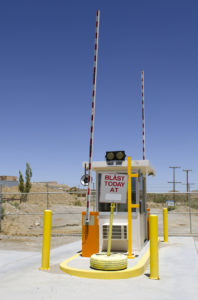
[From the last episode: Even something as simple as a bit can be implemented numerous ways. Getting things to work means getting agreement on details, which, in the simplest cases, are called conventionsAn agreement on some decision that could be made several ways. For example, given a single bit, you could decide that 1 means "true" and 0 means "false," or you could decide the opposite. Similar in spirit to a protocol, but protocols usually deal with how something is done -- a step-by-step process, for example..]
If dealing with a simple bit can be messy, then imagine how much more complex it is to complete high-level tasks that involve thousands and millions and trillions of bitsThe smallest unit of information. It is a shortened form of "binary digit." Since it's binary, it can have only two values -- typically 0 and 1.. An example of one such task might be for securityRefers to whether or not IoT devices or data are protected from unauthorized viewers.: a new computer wants to get onto the networkA collection of items like computers, printers, phones, and other electronic items that are connected together by switches and routers. A network allows the connected devices to talk to each other electronically. The internet is an example of an extremely large network. Your home network, if you have one, is an example of a small local network. so that it can talk to other machinesIn our context, a machine is anything that isn't human (or living). That includes electronic equipment like computers and phones. on the network. Should it be allowed on? What if it’s a hackerA misused, but common term for an unauthorized person trying to break into a device or network. Originally, in this context, "hackers" referred to the good guys (or "white hats"), while "crackers" were the bad guys (black hats).? We need to make sure that the new computer is being used by someone who has permission to use the network.
A Simple Protocol

To set up for that problem, let’s start with another analogy. Picture trying to enter a super-secret military base. Or maybe a secure area where a road is being blasted. What’s going to happen? You’re going to drive up to that booth that you’ve seen in every military movie ever made. Depending on the movie, either a friendly or a hostile agent will ask you for your papers and ask some questions. He or she will retire to the booth for a few minutes and type something on the computer. Perhaps make a phone call or two. If satisfied, you get your papers back and the gate opens. If not, then… well, that’s when the action starts.
This process of how you enter has a name: it’s a protocol. The word “protocol” has a couple of specific implications. The first is that some process is spelled out in detail: “This is how we do it, step by step. And this is how we handle all the things that might happen along the way.” The second is that everyone has agreed that this is how it should be done. A couple examples:
- When a hospital decides to treat you for a disease, there will be a protocol specifying what meds you should get, how much of them, how often, and what might go wrong – and what to do if something does go wrong.
- When you enter a chamber where the Queen is seated, there are specific ways of doing every little thing. Everyone knows them – and anyone that doesn’t will be quickly schooled. It’s a matter of protocol.
Protocols in Electronics
Electronic systemsThis is a very generic term for any collection of components that, all together, can do something. Systems can be built from subsystems. Examples are your cell phone; your computer; the radio in your car; anything that seems like a "whole." also use protocolsAn agreed way of doing something. Like a convention, except that protocols tend to be related to processes. – and they call them protocols. There are hundreds upon hundreds of protocols out there in every possible electronic realm. Including one for making sure that a new computer on the network is legitimate. There are electronic equivalents to the papers you hand to the guy in the security booth: certificates and keysA number used to encrypt (or encode) information so that no one can read it. Keys are used when encoding and decoding. You shouldn't have to mess with keys yourself. and other mathematically complex things are passed back and forth before a computer can access a network. How that happens is specified by a protocol. (We’ll look into this and other protocols in more detail sometimes later.)
In our seven-layer stackRelated to communications: A way of organizing parts of a complicated process (like communications) so that any task relies on tasks below it and feeds the tasks above it. Related to computing: A place in memory where you store “where was I?” information when you go from, say, one function into another. Before starting a new function, you store where you were in the old one so that, when the new function ends and you’re back in the old one, you can figure out where you were and continue on., each layer operates using one or more protocols. IPThis can mean two things (at least):
• The Internet Protocol. Governs the addresses of sources and destinations on a network (without worrying about what’s in between). Used on Layer 3 of the stack.
• "Intellectual property." This can have lots of meanings, but, in the computer-chip world, it refers to parts of a chip design that have been built and optimized by one company, which then sells them to other companies that don’t want to design those blocks themselves. They’re not selling actual chips; they’re selling the design of a block that will be used within a chip.
– as in, your IP address – is a protocol. The P stands for “protocol” (the I stands for “internet”). When the IP layer slaps an IP address on your email, then, when it gets to the other side, the receiving IP layer takes the address back off. The protocol specifies how the address is done. (We’ll also look at how addresses work, conceptually, sometime in the future.)
Now… we can agree on how to do something, but we can go further and have some authorities bless that agreement. That’s what we’ll look at next.

Leave a Reply